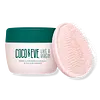What's inside
What's inside
 Key Ingredients
Key Ingredients

No key ingredients
 Benefits
Benefits

 Concerns
Concerns

 Ingredients Side-by-side
Ingredients Side-by-side

Aloe Barbadensis Leaf
MaskingWater
Skin ConditioningCocos Nucifera Oil
MaskingIsopropyl Myristate
EmollientCetearyl Alcohol
EmollientGlyceryl Stearate
EmollientCetyl Alcohol
EmollientPEG-40 Hydrogenated Castor Oil
EmulsifyingCocos Nucifera Water
MaskingButyrospermum Parkii Butter
Skin ConditioningMacadamia Ternifolia Seed Oil
EmollientMicrocrystalline Wax
Emulsion StabilisingHydrogenated Soybean Oil
EmollientPolyquaternium-37
Capryloyl Glycerin/Sebacic Acid Copolymer
Skin ConditioningDiheptyl Succinate
EmollientPropylene Glycol Dicaprylate/Dicaprate
EmollientPPG-1 Trideceth-6
Skin ConditioningStearic Acid
CleansingCeteareth-20
CleansingTapioca Starch
Propylene Glycol
HumectantDMDM Hydantoin
PreservativeDiazolidinyl Urea
PreservativeIodopropynyl Butylcarbamate
PreservativeParfum
MaskingAloe Barbadensis Leaf, Water, Cocos Nucifera Oil, Isopropyl Myristate, Cetearyl Alcohol, Glyceryl Stearate, Cetyl Alcohol, PEG-40 Hydrogenated Castor Oil, Cocos Nucifera Water, Butyrospermum Parkii Butter, Macadamia Ternifolia Seed Oil, Microcrystalline Wax, Hydrogenated Soybean Oil, Polyquaternium-37, Capryloyl Glycerin/Sebacic Acid Copolymer, Diheptyl Succinate, Propylene Glycol Dicaprylate/Dicaprate, PPG-1 Trideceth-6, Stearic Acid, Ceteareth-20, Tapioca Starch, Propylene Glycol, DMDM Hydantoin, Diazolidinyl Urea, Iodopropynyl Butylcarbamate, Parfum
Water
Skin ConditioningCetearyl Alcohol
EmollientCocos Nucifera Fruit Extract
EmollientDimethicone
EmollientBehentrimonium Chloride
PreservativeParfum
MaskingGlycerin
HumectantCetyl Alcohol
EmollientSodium Benzoate
MaskingFicus Carica Fruit Extract
HumectantArgania Spinosa Kernel Oil
EmollientShea Butter Ethyl Esters
EmollientCaryocar Brasiliense Fruit Oil
Skin ConditioningRicinus Communis Seed Oil
MaskingHydrolyzed Linseed Extract
Skin ConditioningLeuconostoc/Radish Root Ferment Filtrate
AntimicrobialPhenoxyethanol
PreservativeCetrimonium Chloride
AntimicrobialPotassium Sorbate
PreservativeEthylhexylglycerin
Skin ConditioningSelaginella Lepidophylla Extract
EmollientSaccharomyces/Silicon Ferment
Skin ConditioningSaccharomyces/Iron Ferment
Skin ConditioningSaccharomyces/Magnesium Ferment
Saccharomyces/Copper Ferment
Skin ConditioningSaccharomyces/Zinc Ferment
Skin ConditioningTocopherol
AntioxidantLactobacillus Ferment
Skin ConditioningBenzyl Alcohol
PerfumingBenzyl Salicylate
PerfumingCoumarin
PerfumingLimonene
PerfumingLinalool
PerfumingWater, Cetearyl Alcohol, Cocos Nucifera Fruit Extract, Dimethicone, Behentrimonium Chloride, Parfum, Glycerin, Cetyl Alcohol, Sodium Benzoate, Ficus Carica Fruit Extract, Argania Spinosa Kernel Oil, Shea Butter Ethyl Esters, Caryocar Brasiliense Fruit Oil, Ricinus Communis Seed Oil, Hydrolyzed Linseed Extract, Leuconostoc/Radish Root Ferment Filtrate, Phenoxyethanol, Cetrimonium Chloride, Potassium Sorbate, Ethylhexylglycerin, Selaginella Lepidophylla Extract, Saccharomyces/Silicon Ferment, Saccharomyces/Iron Ferment, Saccharomyces/Magnesium Ferment, Saccharomyces/Copper Ferment, Saccharomyces/Zinc Ferment, Tocopherol, Lactobacillus Ferment, Benzyl Alcohol, Benzyl Salicylate, Coumarin, Limonene, Linalool
Ingredients Explained
These ingredients are found in both products.
Ingredients higher up in an ingredient list are typically present in a larger amount.
Cetearyl alcohol is a mixture of two fatty alcohols: cetyl alcohol and stearyl alcohol. It is mainly used as an emulsifier. Emulsifiers help prevent the separation of oils and products. Due to its composition, it can also be used to thicken a product or help create foam.
Cetearyl alcohol is an emollient. Emollients help soothe and hydrate the skin by trapping moisture.
Studies show Cetearyl alcohol is non-toxic and non-irritating. The FDA allows products labeled "alcohol-free" to have fatty alcohols.
This ingredient is usually derived from plant oils such as palm, vegetable, or coconut oils. There is debate on whether this ingredient will cause acne.
Due to the fatty acid base, this ingredient may not be Malassezia folliculitis safe.
Learn more about Cetearyl AlcoholCetyl Alcohol is a fatty alcohol. Fatty Alcohols are most often used as an emollient or to thicken a product.
Its main roles are:
Though it has "alcohol" in the name, it is not related to denatured alcohol or ethyl alcohol.
The FDA allows products labeled "alcohol-free" to have fatty alcohols.
Learn more about Cetyl AlcoholParfum is a catch-all term for an ingredient or more that is used to give a scent to products.
Also called "fragrance", this ingredient can be a blend of hundreds of chemicals or plant oils. This means every product with "fragrance" or "parfum" in the ingredients list is a different mixture.
For instance, Habanolide is a proprietary trade name for a specific aroma chemical. When used as a fragrance ingredient in cosmetics, most aroma chemicals fall under the broad labeling category of “FRAGRANCE” or “PARFUM” according to EU and US regulations.
The term 'parfum' or 'fragrance' is not regulated in many countries. In many cases, it is up to the brand to define this term.
For instance, many brands choose to label themselves as "fragrance-free" because they are not using synthetic fragrances. However, their products may still contain ingredients such as essential oils that are considered a fragrance by INCI standards.
One example is Calendula flower extract. Calendula is an essential oil that still imparts a scent or 'fragrance'.
Depending on the blend, the ingredients in the mixture can cause allergies and sensitivities on the skin. Some ingredients that are known EU allergens include linalool and citronellol.
Parfum can also be used to mask or cover an unpleasant scent.
The bottom line is: not all fragrances/parfum/ingredients are created equally. If you are worried about fragrances, we recommend taking a closer look at an ingredient. And of course, we always recommend speaking with a professional.
Learn more about ParfumWater. It's the most common cosmetic ingredient of all. You'll usually see it at the top of ingredient lists, meaning that it makes up the largest part of the product.
So why is it so popular? Water most often acts as a solvent - this means that it helps dissolve other ingredients into the formulation.
You'll also recognize water as that liquid we all need to stay alive. If you see this, drink a glass of water. Stay hydrated!
Learn more about Water